
Food preservation includes processes that make food more resistant to microorganism growth and slow the oxidation of fats. This slows down the decomposition and rancidification process. Food preservation may also include processes that inhibit visual deterioration, such as the enzymatic browning reaction in apples after they are cut during food preparation. By preserving food, food waste can be reduced, which is an important way to decrease production costs and increase the efficiency of food systems, improve food security and nutrition and contribute towards environmental sustainability. For instance, it can reduce the environmental impact of food production.

The cucumber is a widely-cultivated creeping vine plant in the family Cucurbitaceae that bears cylindrical to spherical fruits, which are used as culinary vegetables. Considered an annual plant, there are three main types of cucumber—slicing, pickling, and seedless—within which several cultivars have been created. The cucumber originates in Asia extending from India, Nepal, Bangladesh, China, and Northern Thailand, but now grows on most continents, and many different types of cucumber are grown commercially and traded on the global market. In North America, the term wild cucumber refers to plants in the genera Echinocystis and Marah, though the two are not closely related.
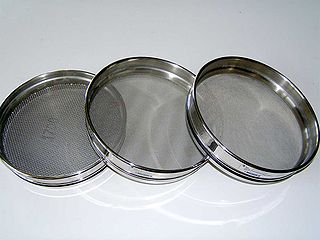
A sieve, fine mesh strainer, or sift, is a tool used for separating wanted elements from unwanted material or for controlling the particle size distribution of a sample, using a screen such as a woven mesh or net or perforated sheet material. The word sift derives from sieve.
Tupperware is an American company that manufactures, and internationally distributes preparation, storage, and serving containers for the kitchen and home. It was founded in 1942 by Earl Tupper, who developed his first bell-shaped container and introduced the products to the public in 1946.
Earl Silas Tupper was an American businessman and inventor, best known as the inventor of Tupperware, an airtight plastic container for storing food, and for founding the related home products company that bears his name, Tupperware Plastics Company.

The Sara Lee Corporation was an American consumer-goods company based in Downers Grove, Illinois. On July 4, 2012, Sara Lee Corporation was split into two companies: one for North American operations renamed Hillshire Brands, the other for international beverage and bakery businesses named D.E Master Blenders 1753.

Pickling is the process of preserving or extending the shelf life of food by either anaerobic fermentation in brine or immersion in vinegar. The pickling procedure typically affects the food's texture and flavor. The resulting food is called a pickle, or, if named, the name is prefaced with the word "pickled". Foods that are pickled include vegetables, fruits, mushrooms, meats, fish, dairy and eggs.

The throw-away society is a generalised description of human social concept strongly influenced by consumerism, whereby the society tends to use items once only, from disposable packaging, and consumer products are not designed for reuse or lifetime use. The term describes a critical view of overconsumption and excessive production of short-lived or disposable items over durable goods that can be repaired, but at its origins, it was viewed as a positive attribute.
Tupperware Brands Corporation, formerly Tupperware Corporation, is an American multinational company that produces home product lines that include kitchen gadgets, preparation, storage containers, and serving products for the kitchen and home. Its main focus is kitchen and household products, and it is particularly known for its line of plastic containers for food storage and preparation. By extension, plastic food containers in general, regardless of brand, are sometimes referred to as Tupperware.

Kosher style refers to foods commonly associated with Jewish cuisine but which may or may not actually be kosher. It is a stylistic designation rather than one based on the laws of kashrut. In some U.S. states, the use of this term in advertising is illegal as a misleading term under consumer protection laws.

Colby-Jack, or Co-jack/Cojack, is an American marble cheese made from Colby and Monterey Jack. It is classified as semi-hard in texture and is mild due to its two-week aging process. It is generally sold in a full-moon or a half-moon shape when it is young. The flavor of Colby-Jack is mild to mellow. Colby-Jack cheese is mainly produced in the states of Wisconsin and California. It is used in various dishes or as a topping to be melted. These dishes include burgers, pasta bakes, macaroni and cheese, casseroles and so on. It is predominantly used in the United States, and is not readily available internationally.
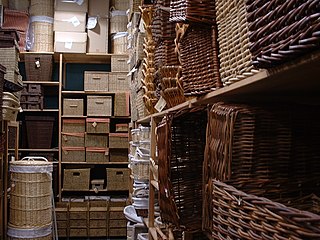
A hamper refers to one of several related basket-like items. In primarily British usage, it refers to a wicker basket, usually large, that is used for the transport of items, often food. In North America, the term generally refers to a household receptacle, often a basket, for clean or dirty clothing, regardless of its composition, i.e. "a laundry hamper". Typically a laundry hamper is used for storage and will be sturdier, taller and have a lid while a laundry basket is open and used mainly for transport.

A flexible intermediate bulk container (FIBC), jumbo, bulk bag, super sack, big bag, or tonne bag is an industrial container made of flexible fabric that is designed for storing and transporting dry, flowable products, such as sand, fertilizer, and granules of plastic.

Home canning or bottling, also known colloquially as putting up or processing, is the process of preserving foods, in particular, fruits, vegetables, and meats, by packing them into glass jars and then heating the jars to create a vacuum seal and kill the organisms that would create spoilage.
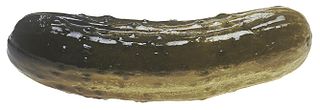
A pickled cucumber – commonly known as a pickle in the United States and Canada and a gherkin in Britain, Ireland, South Africa, Australia, and New Zealand – is a usually small or miniature cucumber that has been pickled in a brine, vinegar, or other solution and left to ferment. The fermentation process is executed either by immersing the cucumbers in an acidic solution or through souring by lacto-fermentation. Pickled cucumbers are often part of mixed pickles.
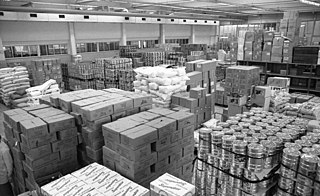
Food storage containers are widespread in use throughout the world and have probably been in use since the first human civilizations.
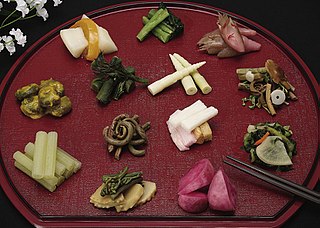
Tsukemono are Japanese preserved vegetables. They are served with rice as an okazu, with drinks as an otsumami (snack), as an accompaniment to or garnish for meals, and as a course in the kaiseki portion of a Japanese tea ceremony.

American Jewish cuisine comprises the food, cooking, and dining customs associated with American Jews. It was heavily influenced by the cuisine of Jewish immigrants who came to the United States from Eastern Europe around the turn of the 20th century. It was further developed in unique ways by the immigrants and their descendants, especially in New York City and other large metropolitan areas of the northeastern U.S.
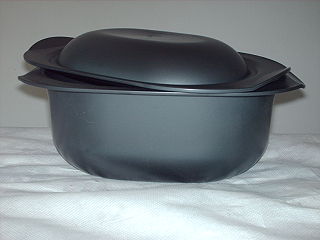
Plastic containers are containers made exclusively or partially of plastic. Plastic containers are ubiquitous either as single-use or reuseable/durable plastic cups, plastic bottles, plastic bags, foam food containers, Tupperware, plastic tubes, clamshells, cosmetic containers, up to intermediate bulk containers and various types of containers made of corrugated plastic. The entire packaging industry heavily depends on plastic containers or containers with some plastic content, besides paperboard and other materials. Food storage nowadays relies mainly on plastic food storage containers.

A Jewish deli, also known as a Jewish delicatessen, is a restaurant that serves various traditional dishes of Ashkenazi Jewish cuisine. Best known for their robust sandwiches, such as pastrami on rye, they also specialize in traditional Jewish diaspora soups, such as matzo ball, and other ethnically-rooted dishes. Betraying their roots as retail delicatessens, most also sell a selection of their products, such as sliced meats by the pound, prepared salads, and pickles, and do a thriving take-out trade.

















